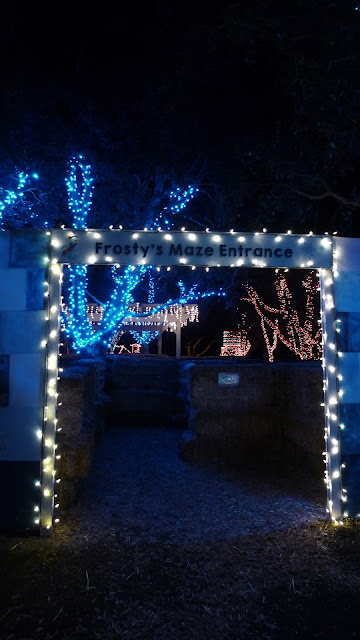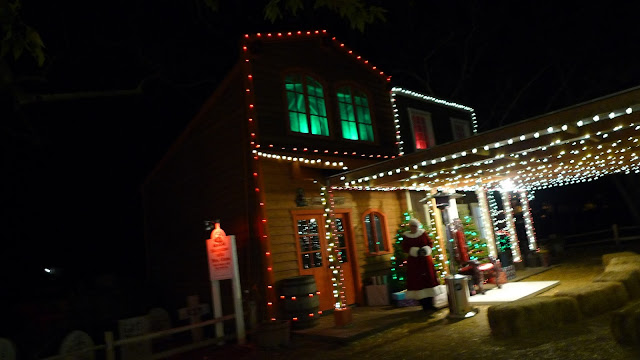Driving from the city and finally getting on the 241 FWY in Irvine, South Orange County, we travelled uphill, then onto mountain roads that were pitch-black, and soon - in the middle of nowhere, Christmas lights began to appear.
We made it! We found it!
The magic of lights transformed the Irvine Park Railroad into a Christmas Village.
Our excitement was building up.
The magic of lights transformed the Irvine Park Railroad into a Christmas Village.
Our excitement was building up.
The Irvine Park Railroad was developed by two good friends - John Ford and Steve Horn, in 1996. Their vision was to make this place "a premier park destination for families" in South Orange County. Their on-the-job training in running a park started with their summer jobs when they were just thirteen, when they spent their summers and vacations at Doheny State Beach, manning the snack bar and eventually taking care of equipment rentals. After college, they came upon an opportunity to operate the food and bike rental concessions at the Irvine Regional Park. They did well. Soon, they signed a lease and embarked on their own concessions business in 1988, giving birth to their catering business - Company Picnic Specialists.
Since 1996, more fun events and activities have been organized for the families and other visitors who come all year-round to the park. Here, families make memories when they come for some fun or to celebrate a special event or occasion.
Since 1996, more fun events and activities have been organized for the families and other visitors who come all year-round to the park. Here, families make memories when they come for some fun or to celebrate a special event or occasion.
And so, we have come to make memories this Christmas holiday season for the little people.
The transformation of this park is magical with the use of Christmas lights. Tree trunks have been wrapped around with lights, and the building structures on site and some typical objects found in the park have been outlined with colored lights.
Park entrance
Bank and Barber Shop
An open carriage with Christmas Bear
The water wheel
A tractor
The shed
With a booklet of tickets, the kids were entitled to join some activities.
Santa Bounce House Jumper
Ice Fishing
A walk through the maze (free)
Christmas Cookie Decorating
Christmas Carnival Games - ring and pillow toss
Every kid walks away with a prize.
Kids checked to see how tall they were. The adults did, too.
On schedule, we got ready to take our train ride at the appointed time - 7:00 to 8:00 p.m. How exciting this was for my grandkids as we were "going" to the North Pole to see Santa.
The tickets for the train ride are sold according to space availability at a specific hour.
Tickets were only sold online. By this time, all the tickets for the train rides were sold out.
Waiting in line
While still in line, I was people-watching - from babies to grandparents, and others of different ages in between. I got to meet and talk to some of them, too.
The train arrived - we got ready to board.
All aboard...
going through the Christmas Village ...
we are gaining speed...
heading into the woods...
passing by the lake...going through an area where it was really dark.
After a few minutes, we saw lights again.
And we had just been informed that we "arrived" in the North Pole and it was time to disembark to see and have a photo op with Santa.
Hot wine, anyone?
And who is Santa? His origins begin with St. Nicholas.
He was born in the 3rd century, in a small village - Patara - formerly a Greek territory, but now found in the southern coast of Turkey. He came from a family with means and he was raised a Christian. Sadly, he was orphaned at a young age when an epidemic took the lives of his parents. In obedience to what he learned from the teachings of Jesus, he used his inheritance in his ministry work - taking care of "the needy, the sick, and the suffering."
He dedicated his life to serving God. While still a young man, he was made Bishop of Myra. His reputation preceded him - he was known for his "generosity to those in need, his love for children, and his concern for sailors and ships."
When Diocletian - the Roman emperor - came to power, he persecuted Christians. For his faith, St. Nicholas suffered as he was exiled and imprisoned, along with criminals. After he was released, he attended the the Council of Nicaea in 325 A.D. (when and where the Nicene Creed and the church canon law were formulated).
He died on December 6, AD 343 in Myra (December 19 in the Julian Calendar) and was buried in his cathedral church. A relic formed in his grave called manna - it is pure water that continues to form in Bari, Italy. In the Eastern tradition, it is called oil, Myron, or Miro. This liquid was said to have healing powers and it led the people to have a devotion to Nicholas.
Many stories and legends have been told about St. Nicholas' life. In death, he was also miraculously helping those in need and those who sought his intercession.
Back to Santa Claus now...
After standing in line - shivering in the cold for about 20 minutes - we got to go up to see Santa and have a picture taken with him. When we left, my 4-year old grandson asked "Why did Santa not give me a present?" Quickly, we explained that Santa was going to drop it off at his house on Christmas eve.
How convincing was that!?!
After our visit to the North Pole, we needed to catch another train to "go back" to the park in Irvine. My grandson said "It is so cold in the North Pole." Boy, it really was! We all braved the 42°F cold, evening temperature.
The train arrived for our return trip.
As we left the North Pole...
we passed through the woods again, then by the lake...and soon...
we approached the entrance to the tunnel...
we raced through ...
A reminder to be nice, just as we were about to leave...then we spotted a sign.
"Story Time with Mrs. Claus"
But poor Mrs. Claus was feeling so cold and so did we.
But poor Mrs. Claus was feeling so cold and so did we.
Back in the lowlands, we had to defrost a bit. Happy but tired, we all went to sleep after an enjoyable time at the Christmas village at the Irvine Park Railroad.
What do you think? After this visit, I think I can scratch off the North Pole from my bucket list. lol
Back to reality now!
The Christmas village and the Christmas tree lot at the park will remain open up to December 23, 2015.





















































